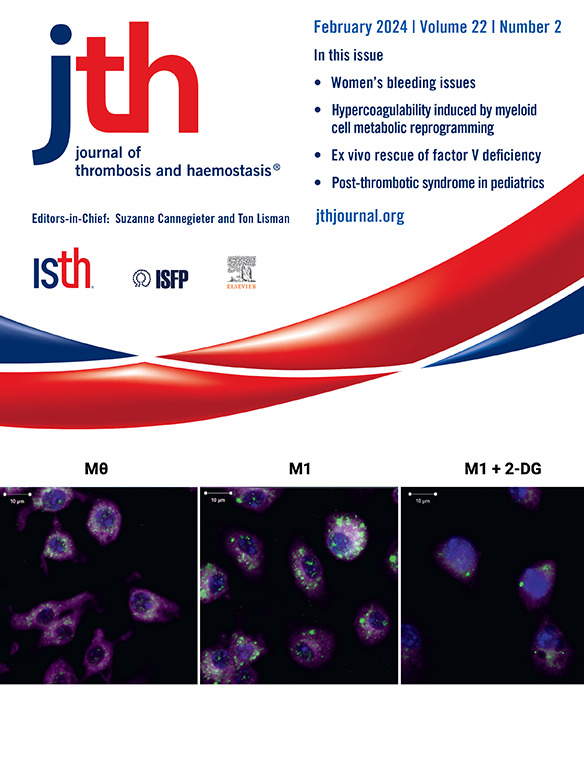Comparing one stage, chromogenic assay results and discrepancies with bleeding phenotype and genetic variants in females with hemophilia A
IF 5.5
2区 医学
Q1 HEMATOLOGY
引用次数: 0
Abstract
Background
Increasing evidence in females with hemophilia A has shown significant bleeding symptoms. Accurate factor (F) VIII activity (FVIII:C) measurement is essential to assign correct diagnosis and severity. Assay discrepancies reported in male patients with hemophilia A are not well studied in females.
Objectives
Our research sought to assess the association of FVIII:C levels by one-stage versus chromogenic assays and the assay discrepancy with bleeding phenotype and genetic mutation in females with hemophilia A.
Methods
Data from 64 females with hemophilia A from our center were reviewed with center’s institutional review board approval. Descriptive statistics, chi-squared, Fisher’s exact, and Bland–Altman plot analysis were applied.
Results
Abnormal International Society on Thrombosis and Haemostasis bleeding assessment tool score was seen in 52% (FVIII:C <40 IU/dL: 72%/73%; FVIII:C ≥40 IU/dL: 41%/45%; by one-stage and chromogenic assays, respectively), more often in adults and postmenarchal patients. Assay discrepancies were present, direct more often than inverse. Based on one assay result only, 11 (17%) patients would have been incorrectly diagnosed and 1 (1.5%) patient would have been assigned incorrect hemophilia severity. No associations of genetic variants with FVIII:C levels and bleeding phenotype were found.
Conclusion
Our study emphasizes the importance of evaluating female patients with hemophilia A for bleeding phenotype. Our study is the first to document prevalence of assay discrepancies exclusively in females with hemophilia A, which can lead to inaccurate diagnosis and severity assignment. Future larger, multicenter studies are needed to validate our findings, to help develop recommendations regarding the appropriate use of assays for accurate diagnosis and to further elucidate the association of genetic variants with bleeding phenotype and assay discrepancies.
比较 A 型血友病女性患者的单阶段显色测定结果以及与出血表型和遗传变异的差异。
背景:越来越多的证据表明,女性血友病 A 患者有明显的出血症状。准确测量第八因子活性(FVIII:C)对正确诊断/病情严重程度至关重要。据报道,A 型血友病男性患者的化验结果存在差异,但对女性患者的化验结果却没有进行深入研究:我们的研究旨在评估 FVIII:C 水平的单阶段测定法与染色测定法之间的关系,以及测定法差异与 A 型血友病女性患者出血表型和基因突变之间的关系:经本中心的 IRB 批准,对本中心 64 名女性血友病 A 患者的数据进行了审查。结果:ISTH BAT 异常的女性血友病 A 患者的出血表型与基因突变之间存在差异:52%的患者 ISTH BAT 评分异常(FVIII:C40 IU/dL:41%/45%;OSA/CSA 分别为41%/45%),更多见于成人和君主制后患者。检测结果存在差异,直接差异多于反向差异。仅根据一项检测结果,就有 11 例(17%)患者被错误诊断,1 例(1.5%)患者的血友病严重程度不正确。没有发现基因变异与 FVIII:C 水平和出血表型有关:我们的研究强调了对女性血友病 A 患者进行出血表型评估的重要性。我们的研究首次记录了女性 A 型血友病患者的检测差异,这可能导致诊断/严重程度分配不准确。今后需要进行更大规模的多中心研究来验证我们的发现,帮助制定有关适当使用化验方法进行准确诊断的建议,并进一步阐明遗传变异与出血表型和化验差异的关系。
本文章由计算机程序翻译,如有差异,请以英文原文为准。
求助全文
约1分钟内获得全文
求助全文
来源期刊
CiteScore
24.30
自引率
3.80%
发文量
321
审稿时长
1 months
期刊介绍:
The Journal of Thrombosis and Haemostasis (JTH) serves as the official journal of the International Society on Thrombosis and Haemostasis. It is dedicated to advancing science related to thrombosis, bleeding disorders, and vascular biology through the dissemination and exchange of information and ideas within the global research community.
Types of Publications:
The journal publishes a variety of content, including:
Original research reports
State-of-the-art reviews
Brief reports
Case reports
Invited commentaries on publications in the Journal
Forum articles
Correspondence
Announcements
Scope of Contributions:
Editors invite contributions from both fundamental and clinical domains. These include:
Basic manuscripts on blood coagulation and fibrinolysis
Studies on proteins and reactions related to thrombosis and haemostasis
Research on blood platelets and their interactions with other biological systems, such as the vessel wall, blood cells, and invading organisms
Clinical manuscripts covering various topics including venous thrombosis, arterial disease, hemophilia, bleeding disorders, and platelet diseases
Clinical manuscripts may encompass etiology, diagnostics, prognosis, prevention, and treatment strategies.

 求助内容:
求助内容: 应助结果提醒方式:
应助结果提醒方式:


